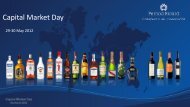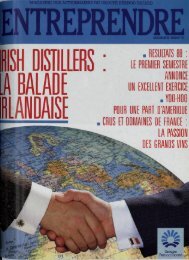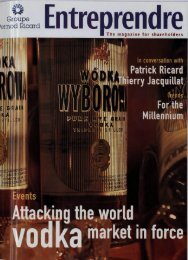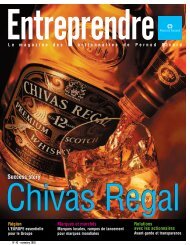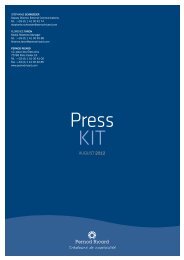Registration Document - Pernod Ricard
Registration Document - Pernod Ricard
Registration Document - Pernod Ricard
Create successful ePaper yourself
Turn your PDF publications into a flip-book with our unique Google optimized e-Paper software.
<strong>Ricard</strong> cemented this commitment by signing an agreement with the<br />
Ministry of Ecology and Sustainable Development and Land Planning,<br />
whereby the Group is set to reduce the quantity of glass sold by 3,000<br />
tonnes in five years.<br />
Measuring and reducing the carbon<br />
footprint of businesses<br />
In 2008/2009, direct emissions from <strong>Pernod</strong> <strong>Ricard</strong>’s production sites<br />
totalled 299,810 T of CO . Glass purchases account for approximately<br />
2<br />
586,000 T of CO , and paper/cardboard purchases approximately<br />
2<br />
123,000 T (2007/2008 estimates).<br />
<strong>Pernod</strong> <strong>Ricard</strong> will continue to measure its footprint in order to limit<br />
its environmental impact. The Group also intends to work on reducing<br />
it by improving energy efficiency, optimising packaging and logistics<br />
and promoting sustainable farming.<br />
In an effort to better understand its impact on the environment,<br />
<strong>Pernod</strong> <strong>Ricard</strong> is gradually extending greenhouse gas emission<br />
assessments to all geographical regions and businesses, helping<br />
raise the awareness of employees and management. In 2009, a model<br />
was developed that can be used in all of the Group’s production sites<br />
throughout the world to assess its carbon footprint. It will be tested in<br />
six countries then proposed to the entire Group.<br />
The research carried out in 2008 on the two main products that<br />
represent the Group’s businesses (Scotch whiskies and Australian<br />
wines) helped identify and list the impact of these products in terms<br />
of greenhouse gas emissions. They highlighted the major role of<br />
packaging (primarily glass bottles) and to a lesser extent the distilling<br />
process (spirits), transport and farming. In 2008/2009, additional<br />
studies on measuring the carbon footprint were run by <strong>Pernod</strong> <strong>Ricard</strong><br />
New Zealand, <strong>Ricard</strong> and <strong>Pernod</strong> . They confirmed that the proportion<br />
of the direct impact of Group businesses is relatively low compared<br />
Subject Definition Unit<br />
Production<br />
volume<br />
Total<br />
production<br />
a) distilled<br />
alcohol<br />
b) finished<br />
product<br />
PRESENTATION OF THE PERNOD RICARD GROUP 1<br />
Operation and strategy<br />
with the indirect impact linked to the purchase of products and<br />
services.<br />
A number of measures have been taken to reduce the carbon footprint<br />
of businesses, which include logistics, favouring ship or rail transport<br />
over road transport. As a result, 200,000 km of road transport were<br />
avoided in the United Kingdom in 2008. Other measures involving<br />
packaging and energy consumption have been outlined above.<br />
2008/2009 environmental reporting<br />
assessment<br />
Methodology<br />
<strong>Pernod</strong> <strong>Ricard</strong>’s environmental reporting is based on the financial<br />
year (July to June) and concerns all of its industrial production sites<br />
around the world: 113 sites included at 30 June 2009, in addition to<br />
the Lawrenceburg facility in the United States , which was sold in<br />
May 2009 and excluding the San José plant in Cuba. It focuses on<br />
the use of natural resources (water, energy, etc.), waste production<br />
(liquids, solids, gases) and initiatives concerning environmental<br />
control and preservation. Only industrial sites are taken into account<br />
( farmlands, head offices and logistics sites are not included).<br />
For the first time in 2008/2009, reporting includes the 9 sites<br />
resulting from the acquisition of V&S. This change in scope is the<br />
reason for certain significant changes in indicators, in particular due<br />
to the increase in volumes distilled.<br />
The chosen indicators make it possible to monitor the Group’s<br />
environmental performance on the basis of indicators that are<br />
relevant to its industrial activity. They are drawn up using the GRI<br />
(Global Reporting Initiative, version G3), guidelines and principles<br />
while remaining adapted to the Group’s specific activity where<br />
necessary.<br />
Total <strong>Pernod</strong> <strong>Ricard</strong><br />
a) Ratio for 1,000 litres of pure alcohol<br />
b) Ratio for 1,000 litres of finished products<br />
G3 GRI<br />
2006 2007 2008 2009 Unit 2006 2007 2008 2009 Index<br />
kL 195,952 220,662 174,729 212,746 - - - - - - -<br />
1,145,225 1,185,449 1,166,177 1,228,829 - - - - -<br />
Water Total volume used m 3 7,182,064 7,605,066 6,710,552 8,540,794 m 3 /kL a) 36.65 34.46 38.41 40.15 EN8<br />
b) 6.27 6.42 5.75 6.95<br />
Energy Total energy consumed MWh 2,029,538 2,049,267 1,550,242 1,668,747 MWh/kL a) 10.36 9.29 8.87 7.84 EN3<br />
EN4<br />
b) 1.77 1.73 1.33 1.36<br />
Including: Electricity MWh 237,968 246,290 218,929 272,880 MWh/kL b) 0.21 0.21 0.19 0.22<br />
CO 2 emissions Direct emissions CO 2 teq 455,222 463,310 300,013 299,810 CO 2 teq/kL a) 2.32 2.10 1.72 1.41 EN16<br />
Fluorinated<br />
refrigerant gases<br />
Quantity of fluorinated<br />
gases installed<br />
% of HFC in fluorinated<br />
gases installed<br />
Quantity of fluorinated<br />
gases released into the<br />
atmosphere<br />
% of fluorinated gases<br />
released into the<br />
atmosphere<br />
b) 0.40 0.39 0.26 0.24<br />
kg 14,394 20,480 20,249 20,499 - - - - - - EN19<br />
% 23. 6 19. 9 23. 7 27. 2 - - - - - -<br />
kg NA 2,330 2,297 2,940 - - - - - -<br />
% NA 11. 38 11. 34 14. 34 - - - - - -<br />
I REFERENCE DOCUMENT 2008/2009 I PERNOD RICARD 13



